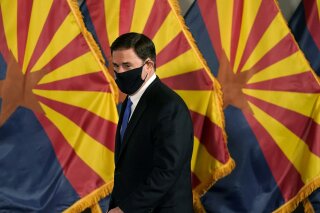Arizona governor lifts mask mandates, reopens bars

FILE - In this Dec. 2, 2020, file photo, Arizona Republican Gov. Doug Ducey arrives for a news conference to talk about the latest Arizona COVID-19 information in Phoenix. Ducey is prohibiting government mask mandates and allowing bars and nightclubs shuttered for months to open their doors without restrictions. Ducey’s move Thursday, March 25, 2021, leaves in place few of the restrictions he implemented to curb the spread of the coronavirus. (AP Photo/Ross D. Franklin, Pool, File)
PHOENIX (AP) — Gov. Doug Ducey on Thursday lifted Arizona’s remaining restrictions to curb the coronavirus, prohibiting government mask mandates and allowing bars and nightclubs shuttered for months to open their doors without restrictions.
The Republican governor cited rising vaccination rates and the opening of vaccine appointments to all adults, as well as a declining number of COVID-19 infections and hospitalizations. His decision was welcomed by business interests and Republican officials, and condemned by public health experts and Democrats.
Ducey encouraged the continued use of masks, particularly among groups of unvaccinated people. His latest executive order allows businesses to enforce mask mandates and distancing requirements if they want, but cities, towns and counties must lift theirs.
Restrictions on gatherings of 50 or more people also were lifted, but organizers are required to “encourage” safety precautions like social distancing.
“I’m confident Arizona’s businesses and citizens will continue to practice the fundamentals and act responsibly as we gradually get back to normal,” Ducey said in a statement.
Reaction fell along largely partisan lines, with Republican lawmakers and mayors welcoming Ducey’s move and Democrats calling it premature and politically motivated.
House Speaker Rusty Bowers, a Republican from Mesa, called it “the right and responsible decision” in a statement released by Ducey’s office.
“Better late then never,” Sen. Michelle Ugenti-Rita, who has pushed to end the emergency declaration that gives Ducey power to impose health restrictions, wrote on Twitter. “To all the (Arizonans) who have suffered so much during this year long shutdown we’re getting there slowly, but surely.”
Phoenix Mayor Kate Gallego, a Democrat, said Ducey’s decision “directly contradicts the best scientists in the field.”
“To abandon precautions now is like spiking the ball on the 5-yard line,” Gallego wrote on Twitter. “We know new variants are circulating. The risk of another surge is real. The governor clearly cares a lot less about the people of Arizona than his political future.”
Arizona’s big hospital chains, which crammed in extra beds and expanded their staff to deal with surges of COVID-19 patients last summer and winter, said the mitigation measures Ducey ended have worked. They urged people to continue taking precautions.
“A downward trend is not synonymous with the elimination of the virus,” hospital executives said in a statement through the Health System Alliance of Arizona, which represents chains including Banner, Dignity and HonorHealth.
Ducey resisted pressure to implement a statewide mask mandate last year even as the virus spread rapidly and hospitals became overcrowded. He eventually allowed local governments require face coverings, and most did.
Ducey says local mask mandates were rarely enforced; mayors say they were instrumental in getting people to comply with the recommendations of public health experts who said masks are instrumental in limiting the spread of the virus. Tucson Mayor Regina Romero said she has no intention of lifting her city’s mask mandate, setting up a potential conflict between the mayor’s power and the governor’s.
Arizona has twice experienced outbreaks that were among the worst in the world at the time but has more recently seen significant improvement in virus metrics. About a quarter of Arizona’s population has received at least one dose of a COVID-19 vaccination and about 16% are fully inoculated. The two most common vaccine varieties require two doses for full protection.
Ducey on Monday opened vaccine appointments to anyone 16 and older, but it will take time for people to get their shots. About 40,000 to 60,000 people got shots each weekday last week, a mix of first and second doses.
The state on Thursday reported 138 additional confirmed COVID-19 cases, the smallest daily increase reported in more than six months. The state reported 81 additional cases on Sept. 8 in the trough between last summer’s surge and the worst one over the fall and winter when daily case reports reached as high as 17,000.
Another 32 deaths were reported Thursday, increasing the state’s pandemic total to 16,874.
Arizona’s seven-day rolling averages of daily new cases and daily deaths continued to decline, according to Johns Hopkins University data.
The rolling average of daily new cases and dropped by more than half over the past two weeks to just over 500 on Tuesday, while deaths fell by nearly a third to 36.6, according to Johns Hopkins University data.
Ducey also faced continued pressure over the state’s rejection of a proposed vaccination site run by the Federal Emergency Management Agency in the Tucson area. The decision has angered officials in southern Arizona. The Pima County Board of Supervisors voted Wednesday to urge him to reconsider, a request echoed Thursday by the five Democrats in Arizona’s U.S. House delegation.
Pressed by Tucson reporters on Wednesday, Ducey said it would be more efficient for FEMA to give the state the 6,000 doses per day that it would have administered.
___
Associated Press writer Paul Davenport contributed.
